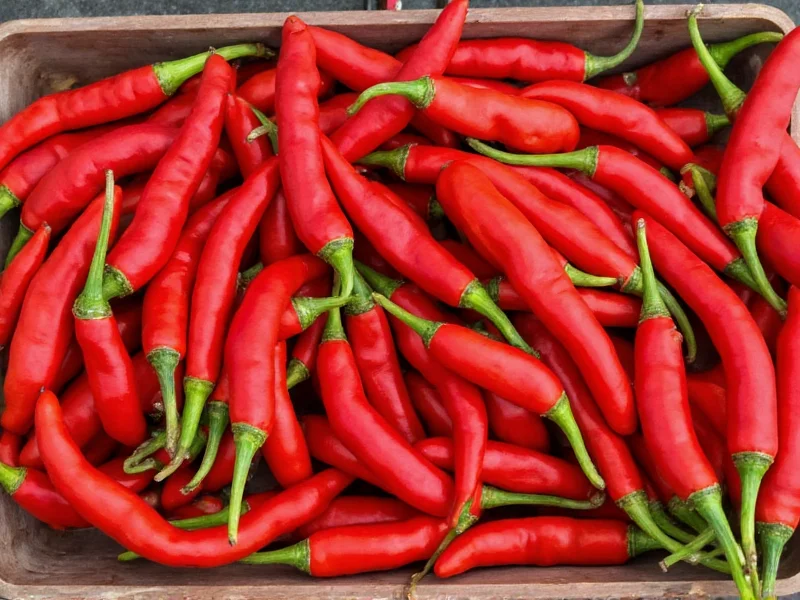When exploring are California chiles hot, it's essential to clarify what we mean by “California chiles.” This term commonly refers to Anaheim peppers, which originated in New Mexico but became widely cultivated in California. Despite the name, they're not particularly hot—in fact, they're among the mildest chili peppers used in mainstream cooking.
Understanding California Chiles: Names and Origins
The confusion around California chile pepper heat level often stems from naming conventions. What many call “California chiles” are typically Anaheim peppers (Capsicum annuum ‘Anaheim’), named after Emilio Ortega's farm in Anaheim, California. These long, green peppers are frequently roasted and used in Southwestern and Mexican cuisine.
It's important to distinguish these from other peppers grown in California, like jalapeños or serranos, which are significantly hotter. When someone asks are Anaheim peppers spicy, the answer remains consistent: they provide gentle warmth rather than intense heat.
Heat Level Analysis: Scoville Scale Comparison
Understanding how hot are California chiles requires examining their position on the Scoville scale:
| Pepper Variety | Scoville Heat Units (SHU) | Heat Level |
|---|---|---|
| California (Anaheim) Chiles | 500–2,500 | Mild |
| Jalapeño | 2,500–8,000 | Medium |
| Serrano | 10,000–23,000 | Medium-Hot |
| Habanero | 100,000–350,000 | Very Hot |
This comparison clearly shows that California chiles sit at the milder end of the spectrum. Most people describe their heat as a gentle warmth that enhances flavor without overwhelming the palate—perfect for dishes where you want pepper flavor without intense spice.
Factors That Affect California Chile Heat
Several elements influence the actual heat level you might experience with California chiles:
- Growing conditions: Stressors like drought or temperature extremes can increase capsaicin production
- Ripeness: As they mature from green to red, heat levels can increase slightly
- Individual variation: Even within the same batch, some peppers may be noticeably hotter
- Preparation method: Removing seeds and membranes significantly reduces heat
When answering are California chiles the same as Anaheim peppers, the answer is generally yes for culinary purposes, though regional growing differences might cause slight variations in flavor and heat.
Culinary Applications of Mild California Chiles
The moderate heat level makes California chiles incredibly versatile in cooking. Chefs value them for what do California chiles taste like—a grassy, slightly sweet flavor with just enough warmth to add dimension without dominating other ingredients.
Common uses include:
- Stuffed with cheese as chiles rellenos
- Roasted and added to salsas and sauces
- Chopped fresh in salads and sandwiches
- Dried and ground into mild chili powder
- Marinated and served as a side dish
For those wondering mild pepper substitutes for California chiles, consider poblano peppers (1,000–2,000 SHU) or even bell peppers for zero heat with similar texture.
California Chiles vs. Other Common Varieties
Understanding California chile vs jalapeño heat helps home cooks make informed choices. While both appear in similar dishes, their heat profiles differ substantially:
- California chiles: Mild warmth, subtle flavor, ideal for everyday cooking
- Jalapeños: Noticeable heat, grassy flavor with citrus notes, better for those who enjoy spicier food
- Poblanos: Similar heat to California chiles but with earthier flavor profile
When recipes call for California chiles but you prefer more heat, consider using a 50/50 mix of Anaheim and jalapeño peppers to maintain flavor while increasing spiciness moderately.
Practical Tips for Cooking with Mild Chiles
Maximize your experience with California chiles using these professional techniques:
- Roasting: Char over open flame or under broiler, then steam in a covered bowl for 10 minutes before peeling
- Storage: Freeze roasted peppers in airtight containers for up to 6 months
- Heat control: Remove seeds and white membranes to further reduce any heat
- Flavor pairing: Complements dairy, citrus, garlic, cumin, and oregano exceptionally well
Remember that even mild peppers like California chiles contain capsaicin, so always wash your hands after handling and avoid touching your face. If you accidentally make a dish too spicy, dairy products like yogurt or sour cream can help neutralize the heat.
Are California chiles the same as Anaheim peppers?
Yes, California chiles typically refer to Anaheim peppers. The name comes from Emilio Ortega's farm in Anaheim, California, where these mild peppers became widely cultivated. While growing conditions might cause slight variations, they're generally considered the same variety in culinary contexts.
Can I substitute California chiles with other peppers?
Yes, excellent substitutes for California chiles include poblano peppers (similar mild heat with earthier flavor) or cubanelle peppers (even milder). For zero heat with similar texture, use bell peppers. If you want slightly more heat, try a 50/50 mix of Anaheim and jalapeño peppers.
Why do some California chiles taste hotter than others?
Several factors affect California chile heat: growing conditions (drought or temperature stress increases heat), ripeness (red peppers are often hotter than green), and individual variation within the same plant. Removing seeds and membranes also significantly reduces perceived heat.
How should I handle California chiles to avoid skin irritation?
While California chiles are mild, they still contain capsaicin. Wear gloves when handling large quantities, especially if you have sensitive skin. Always wash hands thoroughly with soap after handling, and avoid touching your face. If irritation occurs, use milk or yogurt to soothe the affected area rather than water.
What's the best way to preserve California chiles?
Roast and freeze California chiles for best results. After roasting and peeling, place them in airtight containers or freezer bags with minimal air. They'll keep for 6 months. You can also dry them by threading on a string and hanging in a warm, dry place, then store in an airtight container for up to a year.











 浙公网安备
33010002000092号
浙公网安备
33010002000092号 浙B2-20120091-4
浙B2-20120091-4